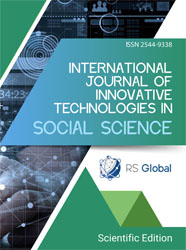A NARRATIVE REVIEW ON THE EFFECTS OF DATE FRUIT (PHOENIX DACTYLIFERA) CONSUMPTION DURING LATE PREGNANCY ON CERVICAL RIPENING, LABOUR INDUCTION AND LABOUR DURATION
Abstract
Introduction: Promoting natural labour with less medical interventions is one of main goals in modern obstetrics. Natural methods have gained more attention in recent years due to their potential to enhance cervical readiness, decrease the need for labour augmentation and shorten labour duration.
Objective: This review aims to investigate the current clinical evidence on the effects of date fruits consumption during late pregnancy on childbirth stages and postpartum complications, particularly concentrating on cervical dilation upon hospital admission, frequency of spontaneous labour onset, and duration of different labour phases.
Material and methods: A narrative review of 6 different randomized controlled trials and cohort studies investigating the impact of daily date intake in late-stage pregnancy on labour-related outcomes was conducted. Data that were extracted included cervical dilatation at hospital admission, frequency of spontaneous labour, need for oxytocin augmentation, and duration of all labour’s phases.
Results: It was found that consumption of around 6–7 dates per day for 2-4 weeks before the estimated delivery date leads to increased cervical dilatation upon hospital admission, higher rates of spontaneous labour onset, shorter duration of all stages of labour (especially the latent and active phases of the first stage of delivery), and reduced need for oxytocin augmentation.
Conclusions: Date fruit consumption appears to be a safe, easily accessible and natural intervention that may positively influence the initiation and progression of labour. However, large, well-designed trials in more diverse populations need to be conducted to further confirm these findings and to establish evidence-based guidelines.
References
Grobman WA. The role of labor induction in modern obstetrics. American Journal of Obstetrics and Gynecology. 2024;230(3):662-8. https://doi.org/10.1016/j.ajog.2022.03.019
Hall HG, Griffiths DL, McKenna LG. The use of complementary and alternative medicine by pregnant women: A literature review. Midwifery. 2011;27(6):817–24. https://doi.org/10.1016/j.midw.2010.08.007
Al-Kuran O, Al-Mehaisen L, Bawadi H, Beitawi S, Amarin Z. The effect of late pregnancy consumption of date fruit on labour and delivery. Journal of Obstetrics Gynaecology. 2011;31(1):29-31. https://doi.org/10.3109/01443615.2010.522267
Kordi M, Aghaei Meybodi F, Tara F, Nematy M, Shakeri MT. The effect of date consumption in late pregnancy on the onset of labor in nulliparous women. Iranian Journal of Obstetrics, Gynecology and Infertility. 2013;16(77):9-15. https://doi.org/10.22038/ijogi.2013.2101
Jadidi MY, Sang SJB, Lari H. The effect of date fruit consumption on spontaneous labor. Journal of Pizhūhish dar dīn va salāmat. 2015;1(3):4-10. https://journals.sbmu.ac.ir/en-jrrh/article/view/12008
Kariman N, Yousefy Jadidi M, Jam Bar Sang S, Rahbar N, Afrakhteh M, Lary H. The effect of consumption date fruit on cervical ripening and delivery outcomes. Pajoohandeh Journal. 2015; 20(2):72–7. http://pajoohande.sbmu.ac.ir/article-1-1996-en.html
Razali N, Mohd Nahwari SH, Sulaiman S, Hassan J. Date fruit consumption at term: Effect on length of gestation, labour and delivery. Journal of Obstetrics and Gynaecology. 2017; 37(5):595–600. https://doi.org/10.1080/01443615.2017.1283304
Kordi M, Meybodi FA, Tara F, Fakari FR, Nemati M, Shakeri M. Effect of dates in late pregnancy on the duration of labor in nulliparous women. Iranian Journal of Nursing and Midwifery Research. 2017; 22(5):383–7. https://doi.org/10.4103/ijnmr.ijnmr_213_15
Bowman R, Taylor J, Muggleton S, Davis D. Biophysical effects, safety and efficacy of raspberry leaf use in pregnancy: a systematic integrative review. BMC Complementary Medicine and Therapies. 2021; 21:56. https://doi.org/10.1186/s12906-021-03230-4
Gholami F, Neisani Samani L, Kashanian M, Naseri M, Hosseini AF, Hashemi Nejad SA. Onset of Labor in Post-Term Pregnancy by Chamomile. Iranian Red Crescent Medical Journal. 2016;18(11):e19871. https://doi.org/10.5812/ircmj.19871
Hemmatzadeh S, Mohammad Alizadeh Charandabi S, Veisy A, Mirghafourvand M. Evening primrose oil for cervical ripening in term pregnancies: a systematic review and meta-analysis. Journal of Complementary and Integrative Medicine. 2021;20(2):328-37. https://doi.org/10.1515/jcim-2020-0314
World Health Organization. WHO Traditional Medicine Strategy: 2014–2023. Geneva: WHO; 2013. https://apps.who.int/iris/handle/10665/92455
Dolea C, AbouZahr C. Global burden of obstructed labour in the year 2000. Geneva: WHO; 2003. https://www.who.int/healthinfo/statistics/bod_obstructedlabour.pdf
Tajik P, van der Tuuk K, Koopmans CM, et al. Should cervical favourability play a role in the decision for labour induction in gestational hypertension or mild pre-eclampsia at term? An exploratory analysis of the HYPITAT trial. BJOG: An International Journal of Obstetrics and Gynaecology. 2012;119(9):1123-30. https://doi.org/10.1111/j.1471-0528.2012.03405.x
Carlhäll S, Nelson M, Svenvik M, Axelsson D, Blomberg M. Maternal childbirth experience and time in labor: a population-based cohort study. Scientific Reports. 2022;12(1):11930. https://doi.org/10.1038/s41598-022-14711-y
Vogel JP, Souza JP, Gülmezoglu AM. Patterns and outcomes of induction of labour in Africa and Asia: a secondary analysis of the WHO Global Survey on Maternal and Neonatal Health. PLoS One. 2013;8(6):e65612. https://doi.org/10.1371/journal.pone.0065612
El-Ardat MA, Obradovic Z, Saldo D, Velagic M, Omeragic A, Galijasevic N. The Effects of Date Consumption on Labor and Vaginal Birth. Medical Archives. 2025;79(1):56-60. https://doi.org/10.5455/medarh.2025.79.56-60
Al-Shahib W, Marshall RJ. The fruit of the date palm: its possible use as the best food for the future? International Journal of Food Sciences and Nutrition. 2003;54(4):247-259. https://doi.org/10.1080/09637480120091982
Hantooshzadeh S, Rezaeizadeh G, Nikfar S, et al. A Systematic Review of the Uterine Relaxant Effect of Potassium Channel Openers. Current Drug Discovery Technologies. 2013;10(4):263-9. https://doi.org/10.2174/15701638113109990002
Crowther CA, Hiller JE, Doyle LW, Haslam RR. Magnesium sulphate for preventing preterm birth in threatened preterm labour. Cochrane Database of Systematic Reviews. 2002;(4):CD001060. https://doi.org/10.1002/14651858.cd001060
Kauffman E., Souter V.L., Katon J.G., Sitcov K. Cervical dilation on admission in term spontaneous labor and maternal and newborn outcomes. Obstetrics and Gynecology. 2016 Mar;127(3):481-8. https://doi.org/10.1097/aog.0000000000001294
Makela K, Palomaki O, Korpiharju H, Helminen M, Uotila J. Satisfaction and dissatisfaction with pain relief and birth experience among induced and spontaneous‑onset labours ending in vaginal birth: A prospective cohort study. European Journal of Obstetrics & Gynecology and Reproductive Biology: X. 2023;18:100185. https://doi.org/10.1016/j.eurox.2023.100185
Adler K, Rahkonen L, Kruit H. Maternal childbirth experience in induced and spontaneous labour measured in a visual analog scale and the factors influencing it: a two-year cohort study. BMC Pregnancy and Childbirth. 2020;20:415. https://doi.org/10.1186/s12884-020-03106-4 .
Hong J, Atkinson J, Roddy Mitchell A, et al. Comparison of Maternal Labor-Related Complications and Neonatal Outcomes Following Elective Induction of Labor at 39 Weeks of Gestation vs Expectant Management. JAMA Network Open. 2023;6(5):e2313162. https://doi.org/10.1001/jamanetworkopen.2023.13162 .
Rahnemaei FA, Kashani ZA, Jandaghian-Bidgoli M, Rahimi F, Zaheri F, Abdi F. The impact of the fruit and seed of date on childbirth stages and pregnancy complications. Sultan Qaboos University Medical Journal. 2024;24:483–90. https://doi.org/10.18295/squmj.12.2023.094
Caughey AB, Cahill AG, Guise JM, Rouse DJ. Safe prevention of the primary cesarean delivery. American Journal of Obstetrics and Gynecology. 2014;210(3):179-93. https://doi.org/10.1016/j.ajog.2014.01.026
Sheiner E, Levy A, Feinstein U, Hallak M, Mazor M. Risk factors and outcome of failure to progress during the first stage of labor: a population-based study. Acta Obstetricia et Gynecologica Scandinavica. 2002;100(5):709-14. https://doi.org/10.1080/j.1600-0412.2002.810306.x
Wong CA, Scavone BM, Peaceman AM, et al. The risk of cesarean delivery with neuraxial analgesia given early versus late in labor. New English Journal of Medicine. 2005;352(7):655-65. https://doi.org/10.1056/nejmoa042573
Rouse DJ, Owen J, Hauth JC. Active phase labor arrest: revisiting the 2-hour minimum. Obstetrics and Gynecology. 2001;98(4):550-4. https://doi.org/10.1016/s0029-7844(01)01516-2
Karizaki VM. Iranian dates and ethnic date-based products. Journal of Ethnic Foods. 2017;4(3):204–9. https://doi.org/10.1016/j.jef.2017.08.002
Shahdadi F, Mirzaei HO, Daraei Garmakhany A. Study of phenolic compound and antioxidant activity of date fruit as a function of ripening stages and drying process. Journal of Food Science and Technology. 2015;52(3):1814-9. https://doi.org/10.1007/s13197-013-1177-6
Khallouki F, Ricarte I, Breuer A, Owen RW. Characterization of phenolic compounds in mature Moroccan Medjool date palm fruits (Phoenix dactylifera) by HPLC-DAD-ESI-MS. Journal of Food Composition Analysis. 2018;70:63–71. https://doi.org/10.1016/j.jfca.2018.03.005
Hemmateenejad, B., Karimi, S., Javidnia, K. et al. Classification and assessment of antioxidant activity and phenolic content of different varieties of date palm (Phoenix dactylifera) fruits from Iran. Journal of Iranian Chemical Society. 2015;12(11):1935-43. https://doi.org/10.1007/s13738-015-0668-y
Kordi M, Nasiri N, Safarian M, Esmaili H, Shadjuo K. The effect of oral honey-date syrup intake during labor on labor progress of nulliparous women. Iranian Journal of Obstetrics, Gynecology and Infertility. 2010;13(2):23-30. https://doi.org/10.22038/ijogi.2010.5861
Fathi L, Amraei K, Yari F. The effect of date consumption on the progress of labor in nulliparous women. Journal of Islamic and Iranian Traditional Medicine. 2018; 9(3):219–26. http://jiitm.ir/article-1-1029-en.html
Hinkaew J, Sahasakul Y, Tangsuphoom N, Suttisansanee U. The Effect of Cultivar Variation on Total Phenolic Contents and Antioxidant Activities of Date Palm Fruit (Phoenix Dactylifera L.). Current Research in Nutrition and Food Science Journal. 2020;8(1). https://doi.org/10.12944/crnfsj.8.1.14
Views:
99
Downloads:
51
Copyright (c) 2025 Patrycja Ucieklak, Jarosław Ucieklak, Karol Poplicha, Konrad Poplicha, Piotr Sobkiewicz, Martyna Grodzińska, Tomasz Ufniarski, Maria Kleczkowska, Patrycja Kardasz, Bartłomiej Siuzdak, Marta Jutrzenka, Aleksandra Piech, Karolina Pasierb

This work is licensed under a Creative Commons Attribution 4.0 International License.
All articles are published in open-access and licensed under a Creative Commons Attribution 4.0 International License (CC BY 4.0). Hence, authors retain copyright to the content of the articles.
CC BY 4.0 License allows content to be copied, adapted, displayed, distributed, re-published or otherwise re-used for any purpose including for adaptation and commercial use provided the content is attributed.















